The alphabet*—it’s a seemingly simple invention with a deeper history and longer journey than many people realize. The ancestor of most alphabets used today was invented in the Levant (Eastern Mediterranean coastal region), and the Penn Museum’s new Eastern Mediterranean Gallery showcases this invention as one of the region’s most influential legacies for the modern world. In the three stories that follow, we highlight little-known chapters of the alphabet’s amazing history.
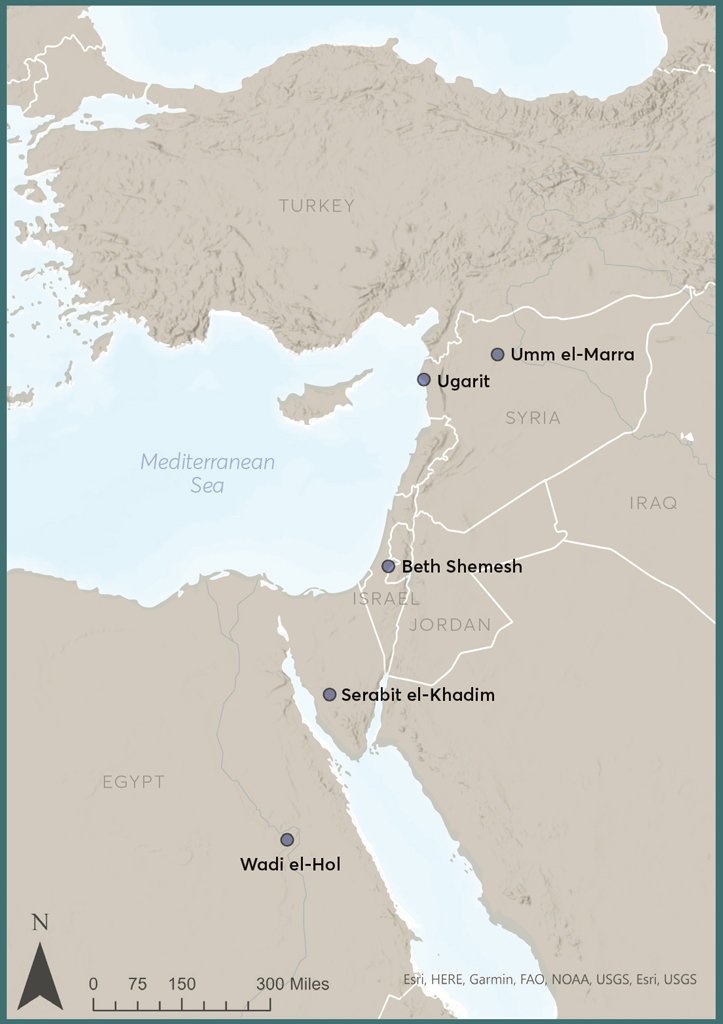
In comparison with the earliest writing systems, Mesopotamian cuneiform and Egyptian hieroglyphs, whose signs convey multiple sounds or whole words and are read differently depending on context, an alphabet has far fewer signs and takes less time to learn. Instead of hundreds of signs, students of alphabetic writing only need to learn twenty to thirty letters to spell out the basic sounds of their spoken language.
To those raised in an alphabetic environment, this writing system appears so logical and self-evidently advantageous that it is no surprise that the alphabet has spread far and wide. As continued prominence of a complex writing system like Chinese hanzi shows, however, widespread literacy does not require an alphabet, and some argue that expressive nuance and creative potential are lost in an alphabet’s simplicity.
Many people know that the Latin alphabet used for English and other languages today developed from the Greek alphabet, and that the Greeks adapted theirs from the Phoenicians. Our first story follows the alphabet’s history back further, to its murky and hotly debated origins in encounters between ancient Egyptian and Levantine people and explores why it took a millennium to come into widespread use. The second story spotlights a remarkable find whose decipherment revealed how both the form and the order of the alphabet we use today could have taken a different path. Finally, the third story takes us o” the well-worn road from the Phoenicians to the modern West and follows instead the alphabet’s long eastward journey through Asia, where it played a role in Mongolian and Chinese empires, the Silk Road, and the spread of Buddhism and Christianity.
These remarkable episodes in the long life of the first alphabet show that its present global dominance was far from inevitable but depended on the twists and turns of history.
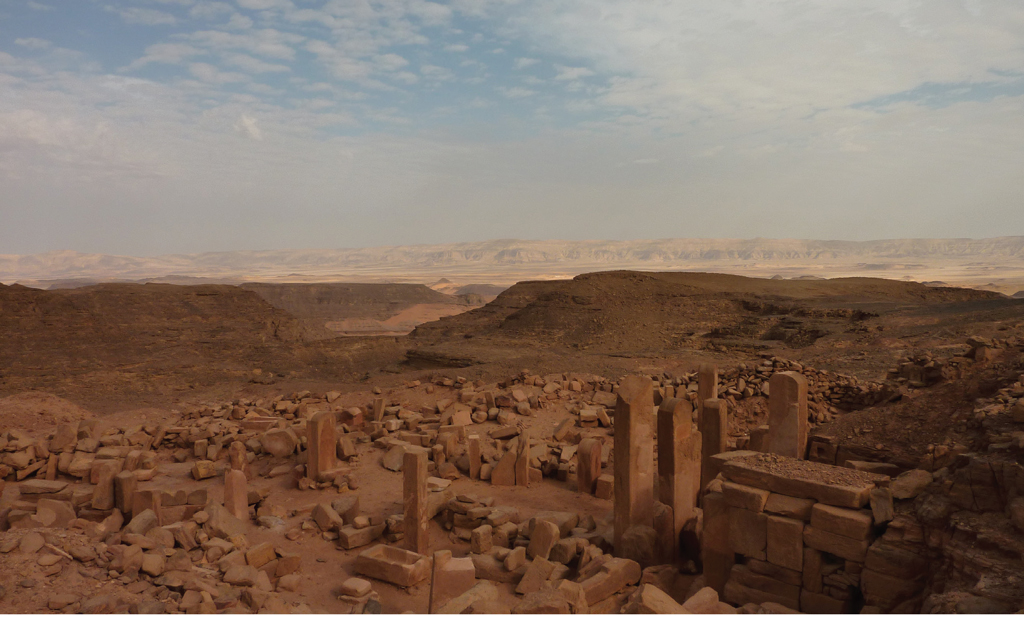
Early to Rise, Late to Bloom
Recent Discoveries Shed Light on the Alphabet’s Origins
By Virginia Herrmann
Herodotus recounts that the Phoenicians taught the alphabet to the Greeks, and, at least on this point, the sometimes fanciful ancient historian has been vindicated by archaeological discoveries. The earliest known Greek alphabetic inscriptions date to the 700s BCE, when Phoenician ships sailed the Mediterranean. For the alphabet’s earlier history, pure speculation was for centuries the only option, until exploration in the Sinai desert led to a breakthrough. Now, a rash of recent discoveries has fed new ideas about how the alphabet came to be and why it took so long to take hold.
In 1905, pioneering archaeologists Flinders and Hilda Petrie explored the Egyptian turquoise mines and Hathor temple at Serabit el-Khadim in the Sinai Peninsula. Among many Egyptian hieroglyphic and hieratic inscriptions there, they also recorded a few dozen unusual pictographic carvings—their signs were similar to certain hieroglyphs, but the inscriptions could not be read as Egyptian. A few years later, Egyptologist Alan Gardiner realized that these were the pictographic prototypes for the linear Phoenician alphabet! Each letter’s sound-value had been derived from the first consonant of the West Semitic word for the object illustrated by the pictograph (a principle known as acrophony): for example, a human-head hieroglyph (read in Egyptian as tp) became the letter r, because the West Semitic word for “head” was raʾsh (later Hebrew rōʾsh). In fact, most Phoenician letters retained the names of their pictorial inspiration—ʾaleph for the ox-head sign, bēt for the house, etc. Since these turquoise mines dated to the 2nd millennium BCE, the Sinai alphabet was a plausible precursor for the Phoenician alphabet written centuries later. Other evidence showed that many Canaanites native to the southern Levant worked the mines in the Pharaoh’s service, placing West Semitic speakers on the scene for the earliest known alphabetic writing.
The “Proto-Sinaitic” alphabetic inscriptions, as they came to be known, could only be partially understood, but most scholars accepted Gardiner’s theory that Canaanite predecessors of the Phoenicians had invented the alphabet with the inspiration of Egyptian hieroglyphs, possibly as early as 1800 BCE. One specialist argues that the inventors were previously illiterate Canaanite miners seeking to express devotion to the goddess of turquoise in their own tongue. Later excavations in Israel and Palestine turned up several more early-alphabetic inscriptions, dated to 1700–1100 BCE and scratched or written in ink on pottery and stone, that showed the letters’ development toward their later abstract linear forms.
Recently, new discoveries of early-alphabetic inscriptions outside the southern Levant hint at hitherto unsuspected chapters in this now century-old story. First, two inscriptions were found at Wadi el-Hol, Egypt, a rocky valley west of the Nile. The alphabetic inscriptions were carved next to Egyptian inscriptions and graffiti dating to the late Middle Kingdom, ca. 1900–1800 BCE. This discovery supported an early date for the Sinai inscriptions, but also raised the possibility that Egypt itself had been the alphabet’s birthplace, rather than the Egyptian-Levantine border. Nearby Egyptian inscriptions mention the leader of a Levantine mercenary force, and much other evidence points to a large migration from the Levant into Egypt during the Middle Kingdom that culminated in the rule of northern Egypt by “Hyksos” kings of Canaanite ancestry. Perhaps, then, Canaanite expatriates immersed in Egyptian culture were the ones who devised a way to write their own language.
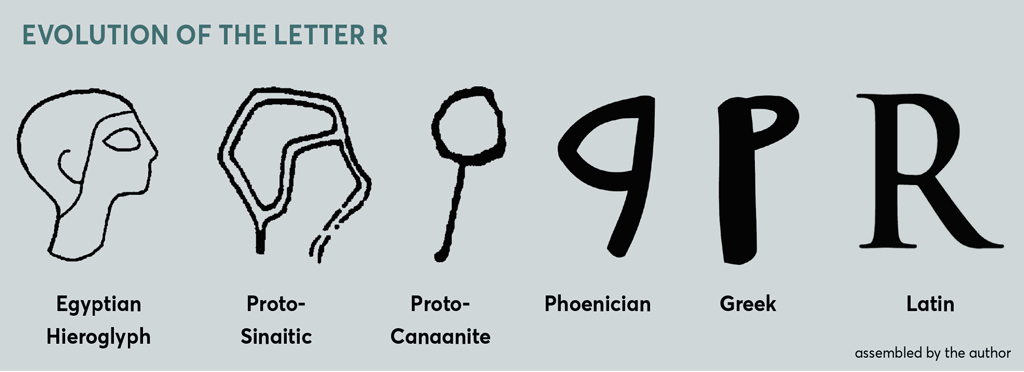
Then came another startling revelation. In an archive from Babylonia dating to ca. 1500 BCE, several cuneiform tablets had short linear alphabetic inscriptions along one edge—the earliest known instance of the practice of writing an alphabetic filing label, or “docket,” on a tablet for easier reference by bilingual scribes. Scholars were amazed that the alphabet had already traveled to Mesopotamia by this early date, and not as an imported novelty, but as a casual expedient in a multilingual setting. This evidence hints that our knowledge of the alphabet’s early use is the tip of an iceberg.
Finally, last year a new study of clay “tags” excavated in a tomb at Umm el-Marra, Syria, cautiously made the case that the inscribed linear symbols are related to the Proto-Sinaitic alphabet. This is a sensational claim, given that the tomb securely dates to ca. 2400–2300 BCE, five to six centuries before the Sinai and Wadi el-Hol inscriptions! Though these inscriptions are short and the letters’ resemblance could be coincidental, if future discoveries uphold this date for the earliest alphabet, it would upend prevailing theories about its invention in the intensive Egyptian-Levantine interactions of the Middle Kingdom and bring it substantially closer to the advent of cuneiform and hieroglyphs between 3400 and 3100 BCE.
These new finds do more than extend the early alphabet’s age and geographic range. They also heighten the long-standing mystery of why we have so few alphabetic inscriptions for a millennium (or more) after the script’s invention. The thread of continuity in the alphabetic tradition across centuries appears remarkably flimsy. Once someone made the breakthrough to create a simple phonetic system, why don’t we see an explosion of literacy, littering the soil with grocery lists and postcards to grandma and grandpa? Part of the answer must be the organic material (namely, papyrus) that the alphabet was designed for, whose perishable nature (outside of extreme conditions) has obliterated most documents from this period. But the rarity and terse character of early inscriptions compared to those from the 1st millennium BCE is nonetheless striking. Some propose that alphabetic writing arose and spread widely within circles of professional scribes, serving as a practical but unofficial script for centuries without breaking through to the vast majority who lacked formal training. Social and political conditions were not yet ripe for widespread literacy. The same scribal community who perpetuated the alphabet were also guardians of the established traditions of cuneiform and hieroglyphs, whose complexity increased the value of their skills. It took the upheaval of the end of the Bronze Age around 1200 BCE, in which Eastern Mediterranean empires fell or retreated and many smaller kingdoms disappeared, to break the dominance of old traditions in the Levant and let a script designed for local languages thrive.
FOR FURTHER READING
- Gardiner, A.H. 1916. The Egyptian Origin of the Semitic Alphabet. Journal of Egyptian Archaeology 3:1–16.
- Koller, A. 2018. The Diffusion of the Alphabet in the Second Millennium BCE: On the Movements of Scribal Ideas from Egypt to the Levant, Mesopotamia, and Yemen. Journal of Egyptian Interconnections 20:1–14.
- Sanders, S.L. 2009. The Invention of Hebrew. Urbana and Chicago: University of Illinois Press.
- Schwartz, G.M. 2021. Non-Cuneiform Writing at Third Millennium Umm El-Marra, Syria: Evidence of an Early Alphabetic Tradition? Pasiphae 15: 255–66.
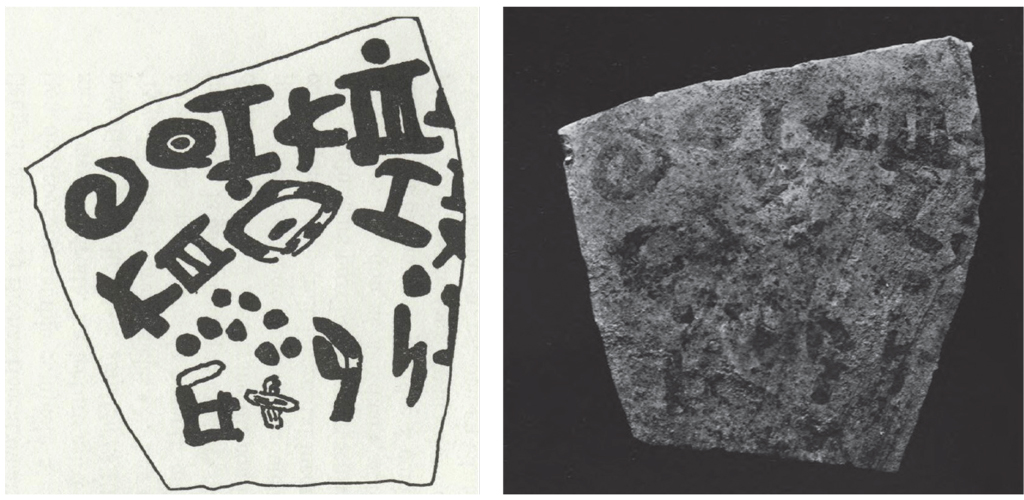
Museum Object Number(s): 61-14-1171
ABCD or HLḤM?
The Alphabet’s Roads Less Traveled
By Virginia R. Herrmann
The 1933 excavations at Beth Shemesh in present-day Israel unearthed a most unusual clay tablet that has raised as many questions as it has answered about the early history of the alphabet. Just four years earlier, an alphabetic type of cuneiform script dating to the 13th century BCE had been discovered in Syria, and experts quickly realized that the Beth Shemesh tablet bore the same type of writing. By the 2nd millennium BCE, cuneiform writing, invented in Mesopotamia, was in widespread use by the royal courts of the Eastern Mediterranean. Cuneiform, like Egyptian hieroglyphs, was a complex script with hundreds of signs that took years to master. In the north Syrian city Ugarit, scribes trained in cuneiform also learned the linear alphabetic script and creatively adapted it to the cuneiform wedges produced by a stylus on clay, thereby inventing the first and only cuneiform alphabet. While they used the regular cuneiform script to write foreign correspondence in the Mesopotamian Akkadian language—the lingua franca of the Near East and Eastern Mediterranean in that period, used for example in the Amarna letters—they wrote epic literature and religious texts in their own Ugaritic alphabet and language (related to later Phoenician and Hebrew). When Ugarit was destroyed ca. 1185 BCE, the cuneiform alphabetic tradition died with it; however, the linear alphabet lived on.
The Beth Shemesh tablet was the first discovery of alphabetic cuneiform so far south, over 500 km from Ugarit, but many things about it were peculiar. The signs looked backwards, some were non-standard in form, and they ran counter-clockwise around the edge of the tablet instead of making neat lines. Scholars even wondered if the tablet—elongated and flat on one side, instead of the usual rectangular pillow shape—had been formed in the mold for a metal axe. It is no wonder, then, that the first attempts to decipher the inscription came up with rather odd, and ultimately incorrect results—a prayer to cure stammering, written in mirror-writing for magical effect, or an incantation addressed to the birth-goddess.
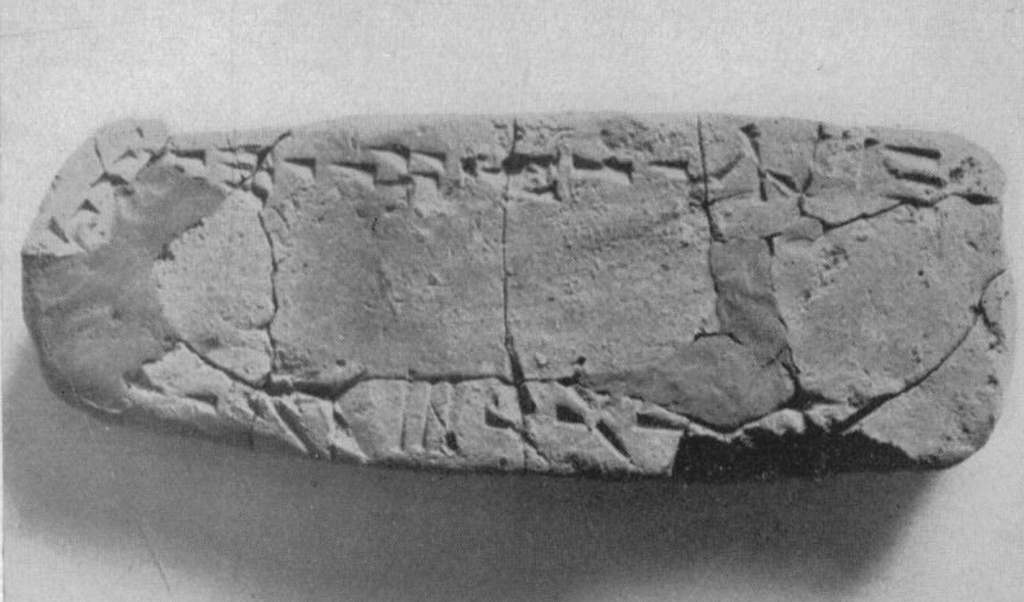
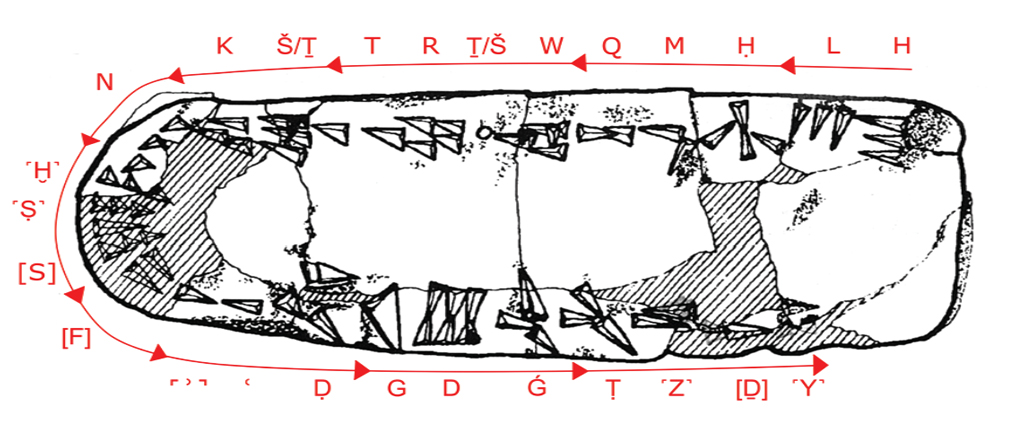
Fifty years passed before Russian scholar A.G. Lundin recognized the Beth Shemesh text for what it was: an abecedary (a text giving the alphabet in order for teaching or study), with a twist. Instead of the more familiar ʾ(a)-b-g-d…(ʾabgad) letter order used by the Ugaritic and later Phoenician and Hebrew alphabets—from which our a-b-c-d… derives—the Beth Shemesh letters had the order h-l-ḥ-m…. This was not a random sequence, but the standard letter order used by abecedaries first attested a millennium later in South Arabia. The Old South Arabian script developed as a distinct southern branch of the alphabet and spread to Eastern Africa, where Ethiopian scripts still u
Fifty years passed before Russian scholar A.G. Lundin recognized the Beth Shemesh text for what it was: an abecedary (a text giving the alphabet in order for teaching or study), with a twist. Instead of the more familiar ʾ(a)-b-g-d…(ʾabgad) letter order used by the Ugaritic and later Phoenician and Hebrew alphabets—from which our a-b-c-d… derives—the Beth Shemesh letters had the order h-l-ḥ-m…. This was not a random sequence, but the standard letter order used by abecedaries first attested a millennium later in South Arabia. The Old South Arabian script developed as a distinct southern branch of the alphabet and spread to Eastern Africa, where Ethiopian scripts still use a variant of the h-l-ḥ-m… order today. Lundin’s brilliant realization at once sparked three new insights:
- the South Arabian alphabetic tradition was at least as old as the Ugaritic/Phoenician one, not derivative of it, as previously believed;
- it had been used not only in Arabia, but also alongside the ʾabgad tradition in the Levant, where it may even have been invented; and
- its early use there was significant enough to warrant its adaptation to cuneiform for writing on clay tablets.
Subsequent discoveries of another halaḥam cuneiform abecedary (halaḥamary?) at Ugarit itself and possibly a third such abecedary found in Egypt and dating even earlier confirmed Lundin’s deduction and showed that the Beth Shemesh abecedary was not a one-o” experiment but part of a robust alternative alphabetic tradition.
Major questions remain about this fork in the early history of the alphabet, which, if it had gone a different way, might have resulted in millions of preschool children today singing a very different alphabet song. Where and why did the split between these two competing alphabetic orders occur? Where and how did the alternative halaḥam order survive to resurface in South Arabia centuries later? Was it associated already in the 2nd millennium BCE with particular Semitic languages—possibly South Semitic languages like those of Yemen and Ethiopia? And why would someone form a tablet for alphabet study in an axe mold? At the moment, our evidence is silent on these points. But any day, another new discovery like the Beth Shemesh tablet could revolutionize our understanding of the alphabet’s complex history.
FOR FURTHER READING
- Pardee, D. 2006. The Ugaritic Alphabetic Cuneiform Writing System in the Context of Other Alphabetic Systems. In Studies in Semitic and Afroasiatic Linguistics Presented to Gene B. Gragg, C. L. Miller, ed. Studies in Ancient Oriental Civilization 60. Chicago: Oriental Institute, 181–200.
- Puech, E. 1991. La tablette cunéiforme de Bet Shemesh: premier témoin de la séquence des lettres du sudsémitique. In Phoinikeia Grammata. Lire et écrire en Méditerannée. Actes du Colloque de Liège, 15-18 novembre 1989, eds. C. Baurain, C. Bonnet, and V. Krings. Liège, 33-47.
| Ugaritic | Phoenician | Old South Arabian | Beth Shemesh Tablet |
|---|---|---|---|
| ʾA | ʾ | H | H |
| B | B | L | L |
| G | G | Ḥ | Ḥ |
| Ḫ | M | M | |
| D | D | Q | Q |
| H | H | W | W |
| W | W | S2 | Ṯ/Š |
| Z | Z | R | R |
| Ḥ | Ḥ | B | |
| Ṭ | Ṭ | T | T |
| Y | Y | S1 | Š/Ṯ |
| K | K | K | K |
| Š | N | N | |
| L | L | Ḫ | ˹Ḫ˺ |
| M | M | Ṣ | ˹Ṣ˺ |
| Ḏ | S3 | [S] | |
| N | N | F | [F] |
| Ẓ | ʾ | ˹ʾ˺ | |
| S | S | ʿ | ʿ |
| ʿ | ʿ | Ḍ | Ḍ |
| P | P | G | G |
| Ṣ | Ṣ | D | D |
| Q | Q | Ǵ | Ǵ |
| R | R | Ṭ | Ṭ |
| Ṯ | Š | Z | ˹Z˺ |
| Ǵ | Ḏ | [Ḏ] | |
| T | T | Y | ˹Y˺ |
| ʾI | Ṯ | ||
| ʾU | Ẓ | ||
| Ś |
Glossary
Abecedary: A listing of the letters of the alphabet in a traditional sequence, usually used for teaching and learning.
Acrophony: The pictorial representation and/or naming of a letter by a word whose initial sound that letter represents.
Alphabet: A set of letters, or written signs, that each represent one of the basic phonemes (distinct units of sound) of a language.
Consonantal writing: A writing system that does not represent vowels, but only the consonants and “semi-consonants” (like w and y) of a language. Both Egyptian hieroglyphs and the early Semitic alphabets use consonantal writing.
Cuneiform: A writing system that used a reed stylus to impress wedge-shaped signs into clay. Cuneiform was invented in Mesopotamia in the 4th millennium BCE and used to write a variety of languages until the 1st century CE. Although a cuneiform alphabet was developed at Ugarit, most cuneiform writing used sets of hundreds of signs that could be read either phonetically, as syllables, or logographically, as whole words. Each sign had multiple possible readings depending on its context.
Hieroglyphs: A pictographic writing system such as that used by the ancient Egyptians beginning in the 4th millennium BCE and continuing until the 5th century CE. In Egyptian hieroglyphs, the symbols could be read either phonetically, as one or more consonants, or logographically, as whole words. Each sign had multiple possible readings depending on its context. Egyptian hieroglyphs were a consonantal writing system.
Pictograph: A symbol in a writing system that graphically represents a physical object. Sometimes also called a pictogram.
Proto-Sinaitic and Proto-Canaanite: The earliest known alphabet, a consonantal writing system used to write Semitic languages in the Levant and Egypt in the 2nd millennium BCE. The form found in the Sinai Peninsula is called Proto-Sinaitic, while inscriptions found in the Levant are called Proto-Canaanite.
Influence and Adaptation
The Alphabet in Central and East Asia
By Adam Smith
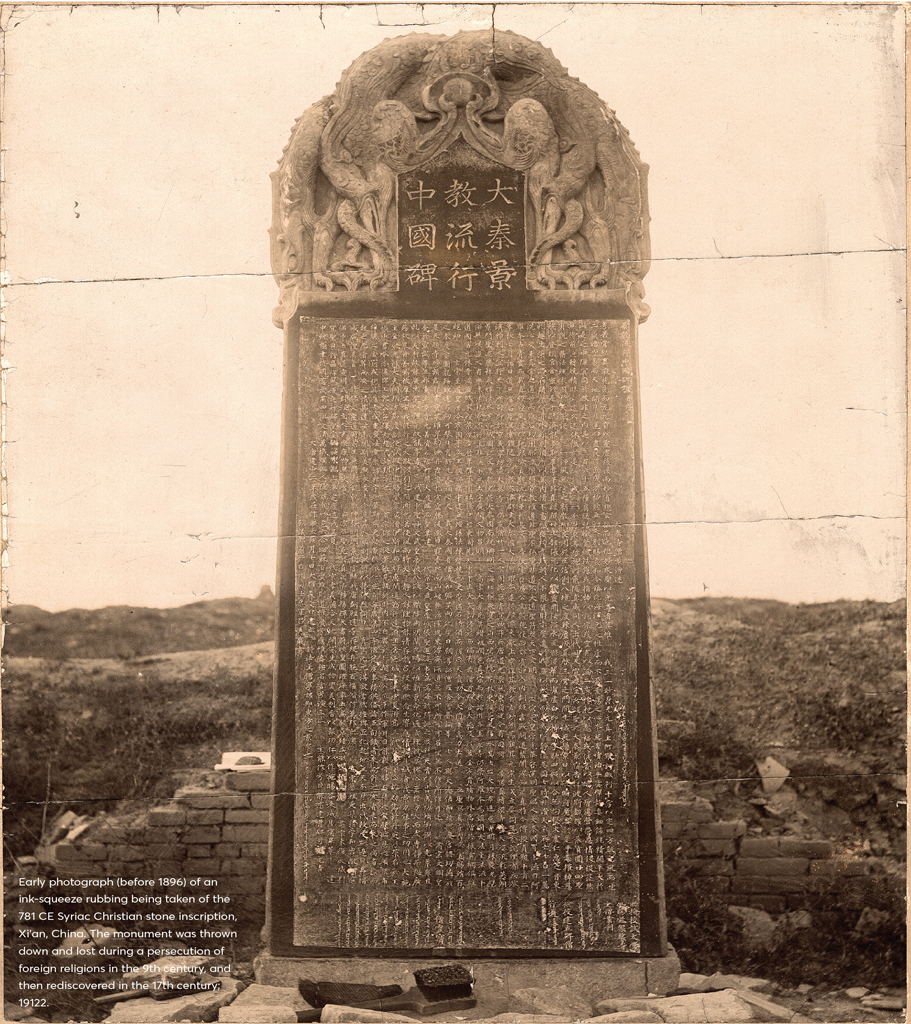
Around the same time that the Greeks were adapting Phoenician letters to write their own language, speakers of Aramaic, a language closely related to Hebrew, did the same. The Greeks initiated the spread of the alphabet westwards around the Mediterranean and ultimately all over Europe. The use of Aramaic by the Greeks’ rivals, the Achaemenid Persian Empire, established its use throughout the Near East and gave rise to a dazzling cascade of further borrowings and adaptations that over the course of two thousand years reached regions as far away from the Mediterranean as Manchuria and Beijing, and languages as diverse as Mongolian, Sogdian, Uyghur, and Gāndhārī.
The Achaemenid Empire and the reach of the Aramaic alphabet extended east as far as the Indus and Central Asia. After the fall of the Achaemenids, the conquests of Alexander in the 4th century BCE brought the Greek language and its alphabet to those same regions. The two cousin alphabets, Greek and Aramaic, appear together in a famous bilingual rock inscription near Kandahar, Afghanistan, carved for the Indian king Ashoka in 260 BCE, half a century after Alexander. Ashoka carved monumental inscriptions on exposed rock surfaces and stone pillars all over the Indian subcontinent, in scripts tailored to regional linguistic variation. Alongside Greek and Aramaic, the most northerly inscriptions are in an Indian language, written in the Kharoṣṭhī alphabet. The letter forms and sounds of Kharoṣṭhī are easily matched to those of Aramaic from which this Central Asian variant derived. Ashoka’s inscriptions throughout the rest of India are written in yet another alphabet, Brāhmī. The first appearance of the Brāhmī alphabet, in inscriptions by a king who also used Aramaic, suggests that it too may have been inspired by an Eastern Mediterranean alphabet. The letter forms are much harder to match convincingly, and however, for that reason the origins of Brāhmī and connections to Aramaic are unresolved. Whatever its origins, Brāhmī developed into the alphabets for countless languages of South and Southeast Asia and Tibet.
There were still Greek kings in Central Asia, in what is now Afghanistan and Pakistan, with Greek names and using the Greek and Kharoṣṭhī alphabets, for more than two centuries after Alexander. The name of King Menander I (2nd century BCE) appears on the coin seen in the center of this page. Like Ashoka’s Kandahar inscription, the legend on the coin is bilingual, with Greek on one side and the Aramaic-derived Kharoṣṭhī alphabet on the other.
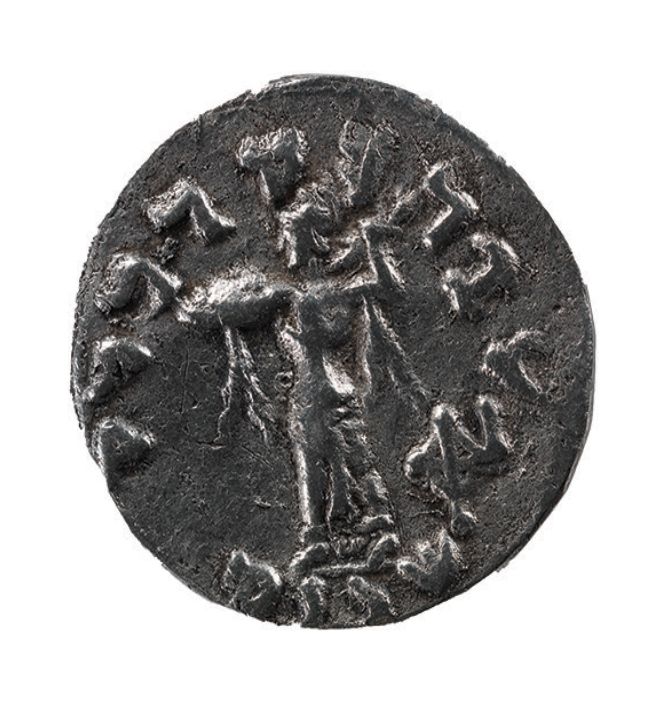
Museum Object Number(s): 29-126-526
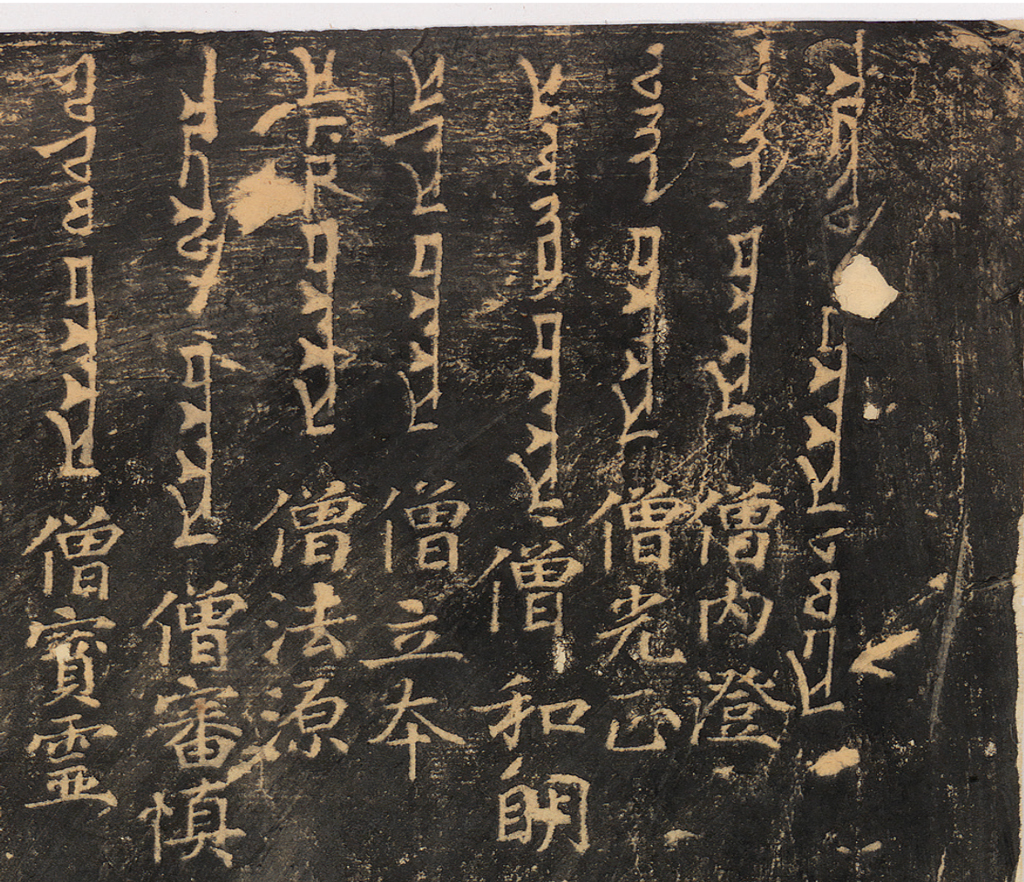
Museum Object Number(s): 19121B
Buddhist tradition recognizes King Ashoka as the great early patron of Buddhism, who distributed the Buddha’s relics (bodily remains) in commemorative monuments across his Indian empire. King Menander also appears in Socratic dialog with the Buddhist sage Nāgasena in an early text, “The Questions of Milinda,” the title of which uses an Indian version of his name. The Kharoṣṭhī alphabet used by both kings was also the medium for Buddhist literature. The earliest Buddhist manuscripts that survive today are written using the Kharoṣṭhī alphabet in Gāndhārī, another Indian language.
The creation of the Chinese script around 1300 BCE was completely independent of the alphabet and other Near Eastern writing systems. For about two thousand years, Chinese was the only script that most people in East Asia would ever encounter. During the early medieval period, foreign communities that settled in the Chinese-speaking regions that are now the People’s Republic of China often brought their languages and their Aramaic-derived alphabets with them.
The Sogdians dominated Silk Road trade between the medieval Chinese states and Sogdian homelands in Central Asia. Sogdians living in Chinese cities in the 6th century CE were commemorated upon their deaths with epitaphs inscribed in their own Iranian language using the alphabet. Syriac Christians similarly brought their language and script with them when they established a community in the Tang dynasty’s capital city, Chang’an. Their most famous monument is a stone inscription erected in 781 CE. Most of the inscription is in Chinese, commemorating the arrival of Syriac Christians during the reign of the Taizong emperor a century earlier and listing their core religious beliefs. A shorter text appears in the Syriac alphabet together with a list of priests’ names.
The Turkic-speaking Uyghurs adopted and modified the alphabet of the Sogdians, and it was Uyghur scribes that brought literacy to the Mongol empire of Genghis Khan and his successors. Unlike earlier Aramaic-derived scripts, the UyghurMongolian script runs top-to-bottom in vertical columns, like the traditional Chinese script. It is only ever written cursively, with ligatures (connecting lines) joining letters and flourishes at the start and end of words, which set it apart visually from the earlier alphabets from which it evolved. The Mongolian alphabet is still an important part of cultural identity for Mongolian speakers in the People’s Republic of China and Mongolia today.
The Manchu Qing Dynasty conquered and ruled China from the palace halls of the Forbidden City in Beijing from the 17th century until 1911. Like the Mongols, they were an ethnolinguistically distinct ruling class in the Chinese-speaking world. The use of the Mongolian alphabet to write their Manchu language (unrelated to Mongolian and Chinese) was the last major step in the spread of the Aramaicderived alphabets in East Asia. Most subjects of the Qing empire never spoke or wrote any Manchu, but they would have seen it in symbolic or ceremonial uses, rather like the use of Latin in the United States on coins, mottoes, and diplomas. The Qing government sometimes rewarded loyal service with documents in Chinese and Manchu bestowing elaborate honorific titles on the recipient’s deceased parents. Qing coins also had legends in Chinese and Manchu, representing the only Manchu writing that most Chinese people would ever encounter. Manchu writing would have evoked for them the distinctive identity of the ruling dynasty, but its remote origins among the alphabets of the Eastern Mediterranean millennia ago would have been as illegible as the script itself was for most readers.

Museum Object Number(s): 2019-6-1
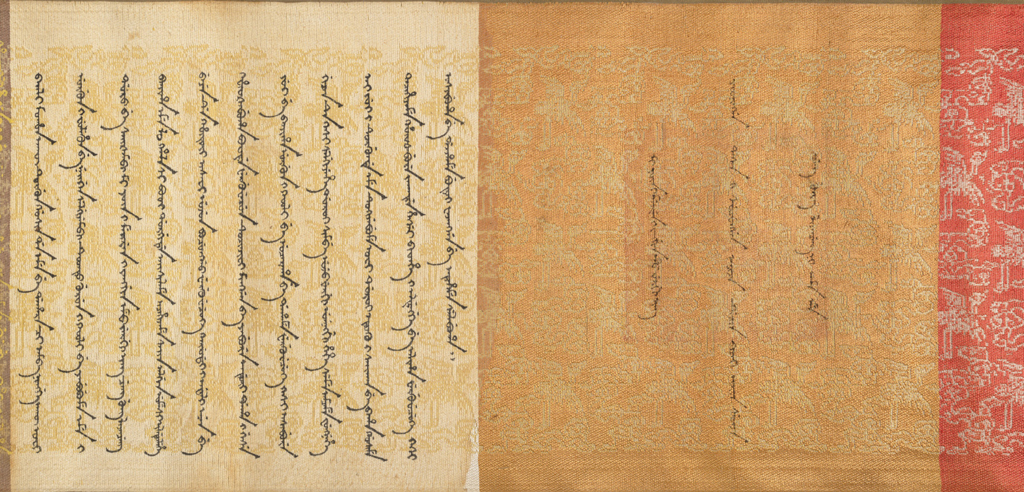
FOR FURTHER READING
- Daniels, P.T. and W. Bright (eds.). 1996. The World’s Writing Systems. New York, Oxford: Oxford University Press.
- Keevak, M. 2008. The Story of a Stele: China’s Nestorian Monument and Its Reception in the West, 1625-1916. Hong Kong: Hong Kong University Press.
- Salomon, R. 1998. Indian Epigraphy: A Guide to the Study of Inscriptions in Sanskrit, Prakrit, and the other Indo-Aryan Languages. Oxford: Oxford University Press.
